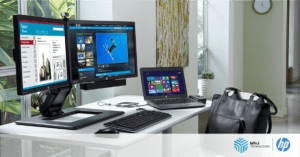Remote work is a part of the new normal. The good news is that this does not need to affect employee productivity negatively. The trick lies in creating the ideal environment for distant collaboration when your team members work from home.
Below, we’ll look at how you can help your team to tailor workspaces that allow for optimal productivity from the moment they sit down (or stand up) at their desks in the morning until they power down at the end of their workday.
Set The Scene With Essential Tech
First things first, you need to ensure that your employees have access to all the technology at home that they would have at their disposal if they were working in the office.
Every remote work environment differs, so there will be certain job-specific technologies at play for each individual industry. However, there is a baseline set-up that applies across the board. It starts with a laptop or PC.
While laptops tend to be the norm for remote workers because of the mobility benefits, some companies are finding that a desktop actually makes more sense. Once users find an ideal space, they don’t need as much mobility for getting the job done. Saving money on a desktop in this way allows more budget for a bigger monitor and peripherals, for instance.
If your team members do use laptops, provide them with access to a separate keyboard, mouse, and monitor if they prefer.
Connectivity
Next up, it’s time to focus on connectivity. If there is one thing that hampers productivity severely, it’s a spotty internet connection and/or the inability to tap into vital applications or data.
To this end, consider equipping your team with the following:
- A high-speed, broadband internet connection
- A VPN to provide secure access to applications and data behind a corporate firewall.
- Remote desktop protocol (RDP) applications.
- Hardware such as an on-site printer if it is essential to daily tasks.
- A quality USB headset for attending virtual meetings.
- A power supply with battery backup and surge protection to protect data in the effect of power outages or fluctuations.
Tailor A Safe & Productive Space
Once the technology is in place, ergonomics come into play. Sitting in front of a monitor all day can wreak havoc with your employees’ health and wellbeing if the environment is not suited to their physical needs.
An ergonomically optimized workspace helps employees to work efficiently and safely. It all starts with setting up a space that supports neutral spinal alignment, i.e. the natural S-shape curve our spines follow from our necks to our tailbones. This calls for:
- A desk or table that an employee can sit comfortably at.
- A chair with proper lumbar support that can be adjusted for individual comfort.
- A working surface on which the keyboard and mouse is at elbow height when the user is seated.
- Monitor height slightly below eye level (i.e. when an employee looks at the middle of the screen, they should be looking slightly downwards).
- Monitor distance at least an arm’s length from the user so they don’t have to move their heads from left to right to see the entire screen.
- Keyboard and mouse placement that allows the user to keep their wrists straight and keep their upper arms close to their body without any force.
Standing desks are also becoming more popular, and with good reason – it burns calories while you work and it’s a welcome change from remaining seated all day. If employees choose to use a standing desk, caution them to introduce it slowly. If you’re used to sitting all day, it’s not a good idea to jump straight to standing for 8 hours.
Similarly to conventional desks, standing desks should also be at the right height for each user. The location of the desk should also allow the user to find the ideal “sweet spot” in terms of proximity to the screen.
Encourage Healthy Habits
Working virtually may seem like an ideal set-up at the outset – there’s no commute, you can work in your yoga pants and accommodate other aspects of your life (e.g. the school run, etc.). However, without the proper processes in place, it can be easy to get distracted or burn out.
Find The Perfect Setting
It starts with choosing the right type of workspace. Although it can be tough to find the perfect environment in every home, employees should ideally opt for a space with natural rather than fluorescent lighting and minimal auditory distractions.
Similarly, a neutral temperature is best – a very warm room can make you sleepy, while a very cold room can be distracting and make typing a chore.
Clear The Clutter
Clearing clutter away is another surefire way to improve concentration. Encourage remote employees to keep their desks tidy, and to introduce indoor plants. Natural greenery in a workspace improves air quality and mood and lowers stress.
Self-Care
From a self-care perspective, it’s also important that your employees stay well-nourished and hydrated, and take care to do some physical activity each day. Here, the old-school dietary rules of thumb still apply – drink at least 8 glasses of water each day and limit caffeine intake. This will help ensure that they don’t feel fatigued or lose concentration throughout the day.
Stick To Scheduled Work Hours
To prevent burn-out, it’s also essential that remote employees set firm work hours and stick to them. When you’re working from home it can be tempting to remain “tuned in” at all times. While this may seem like it would boost productivity, it only does so in the short term. In the long run, it leads to fatigue and burnout.
The Bottom Line
When your team members work from home, it’s very important that their workspaces and lifestyle choices are tailored for optimal productivity. By sharing the information above, you can help them to address many of the day-to-day challenges of remote work.
MNJ and HP are delivering the solutions you need to manage your remote workforce successfully – Contact us to learn more at sales@mnjtech.com.




